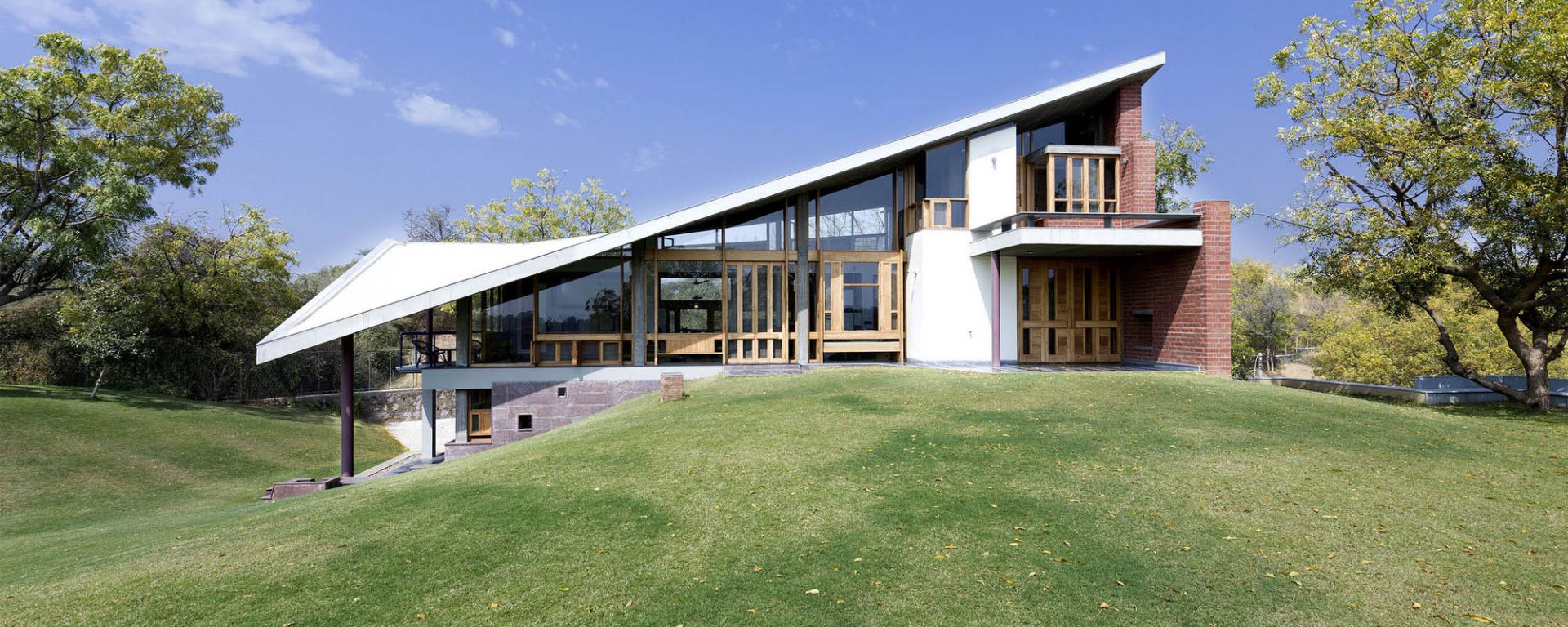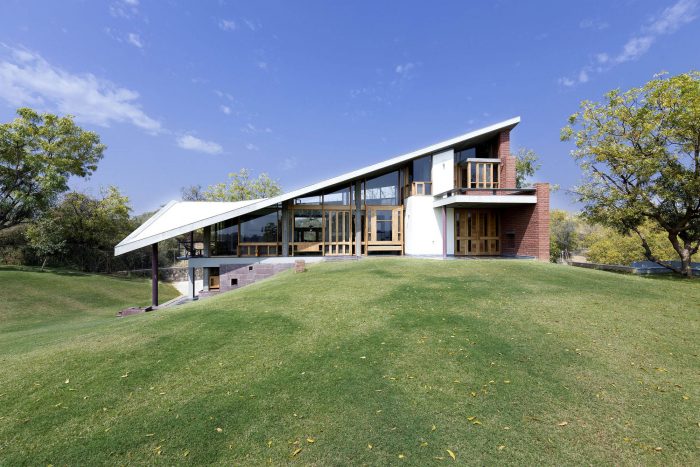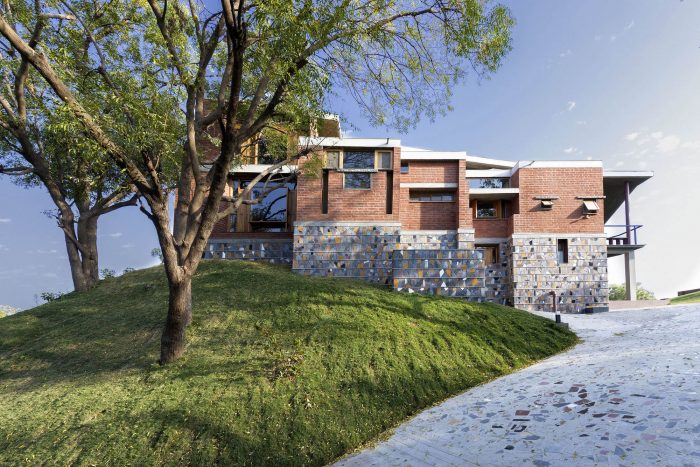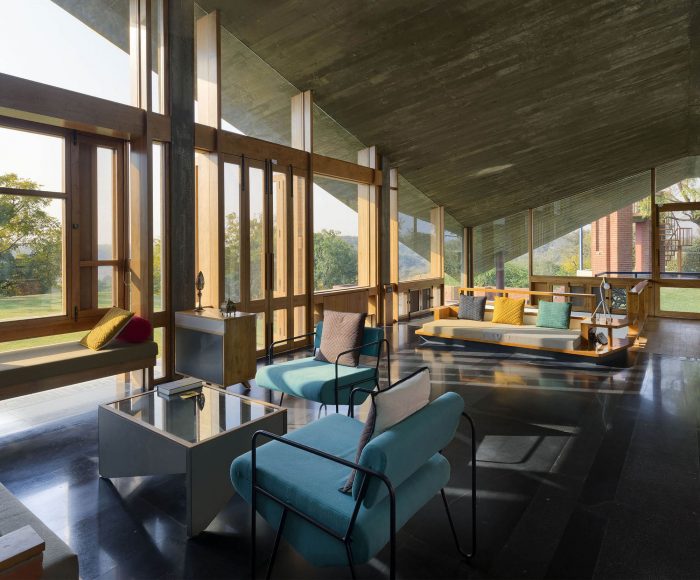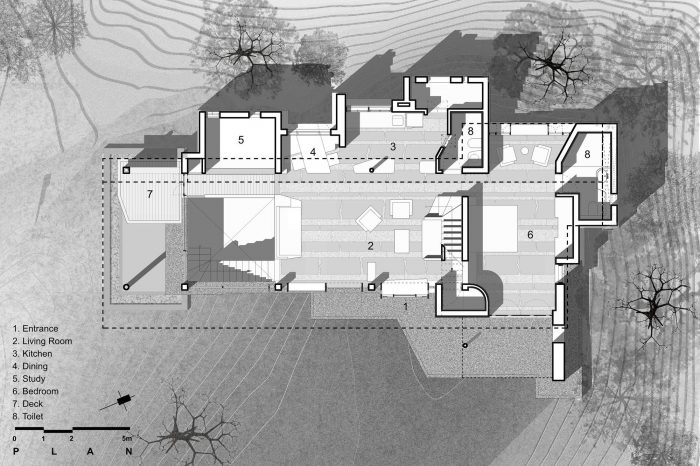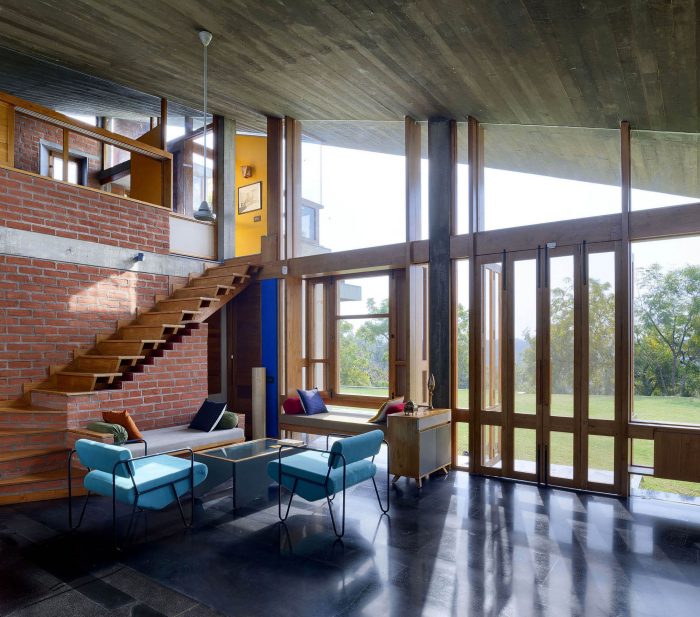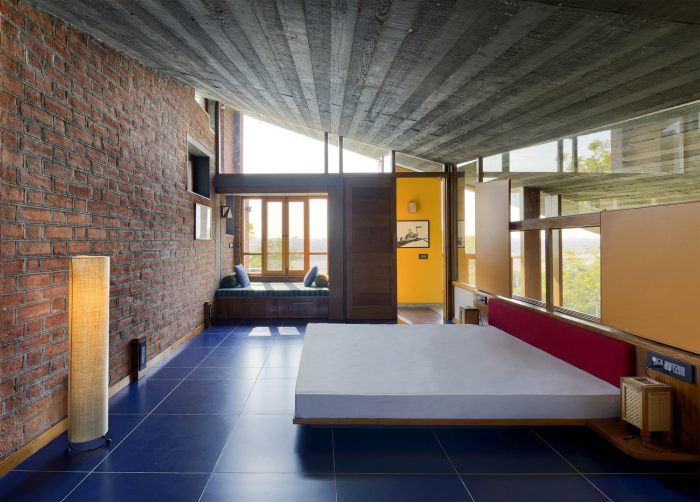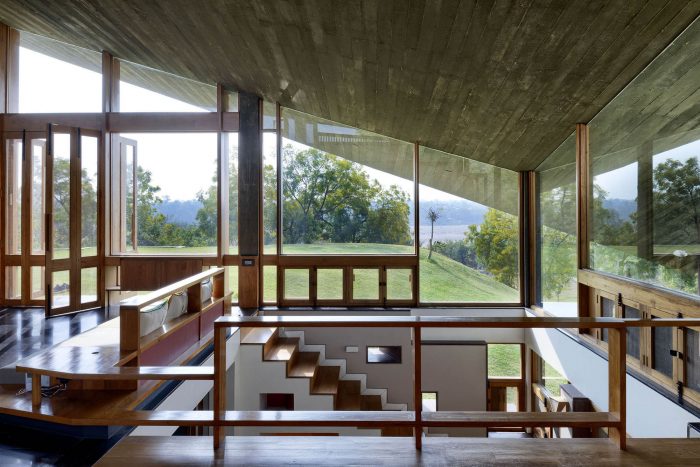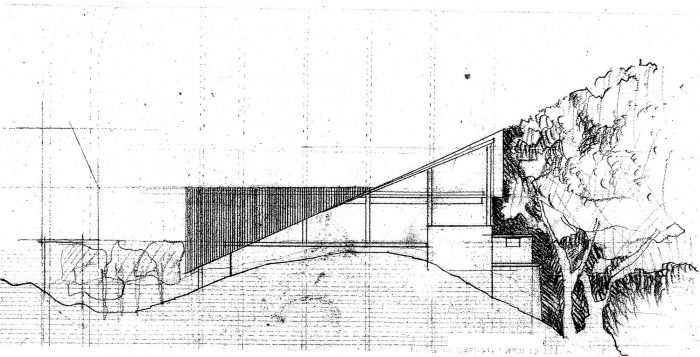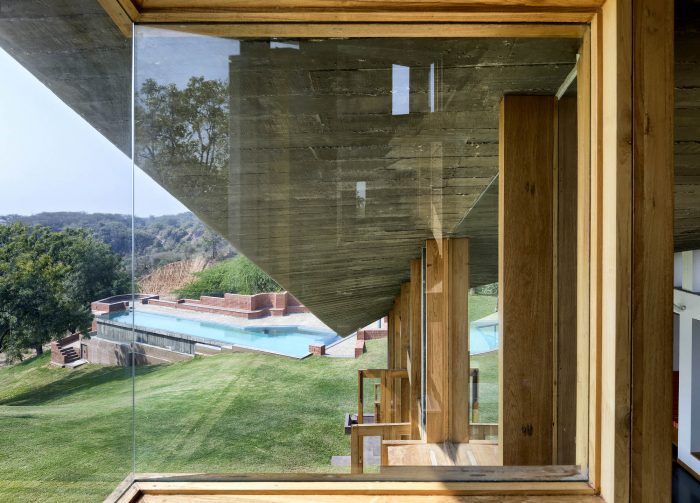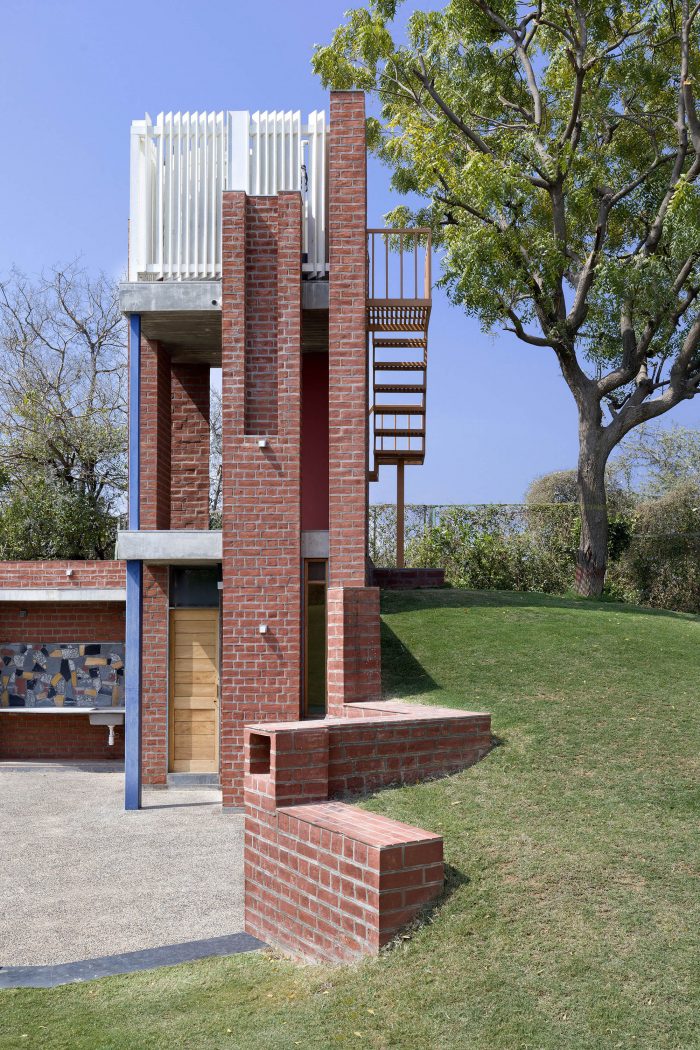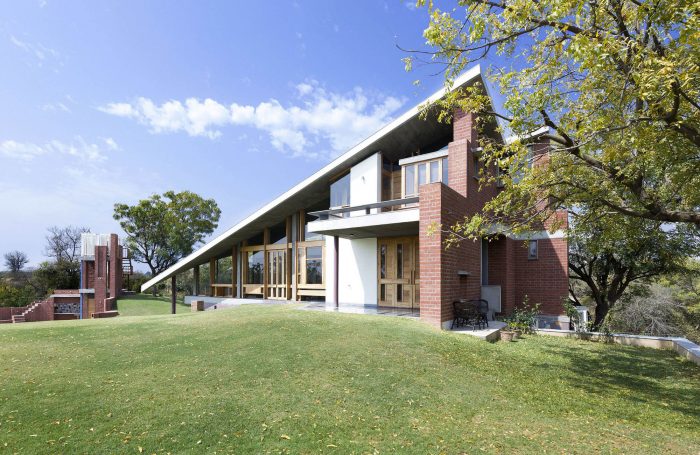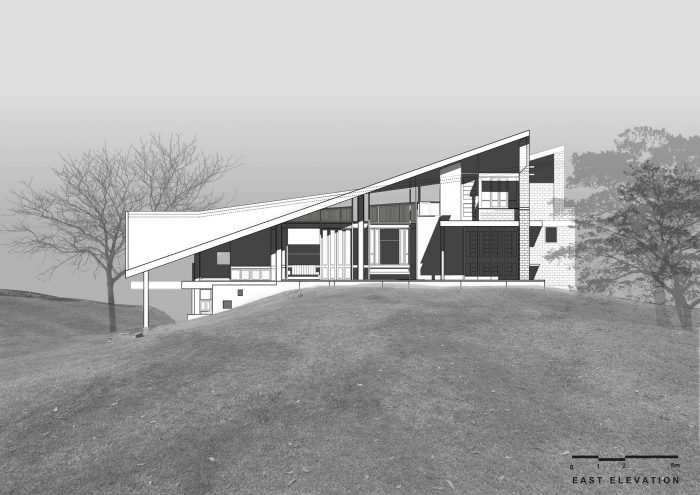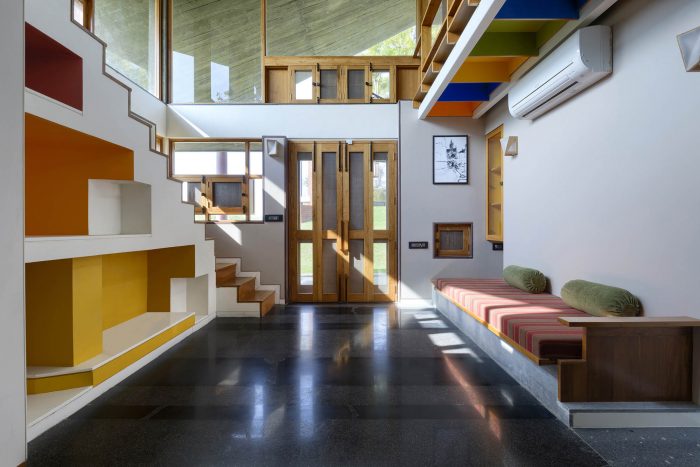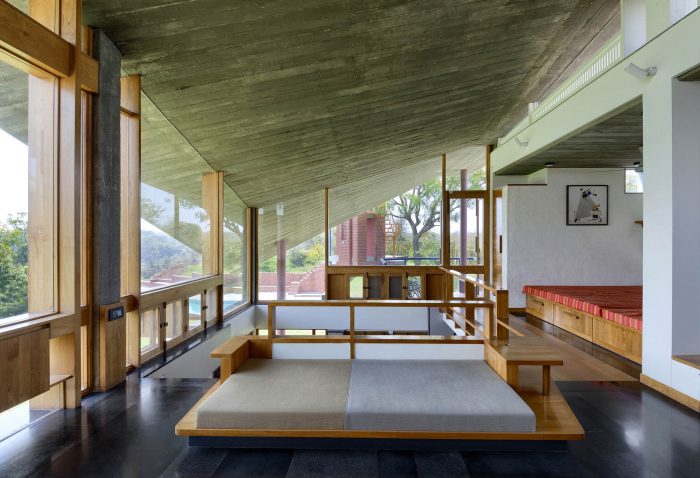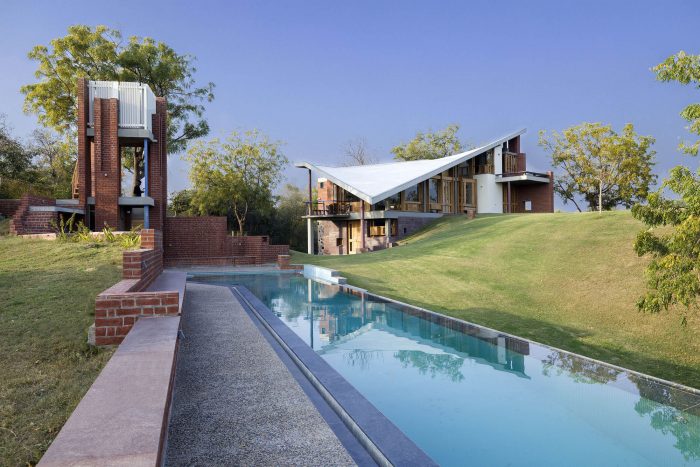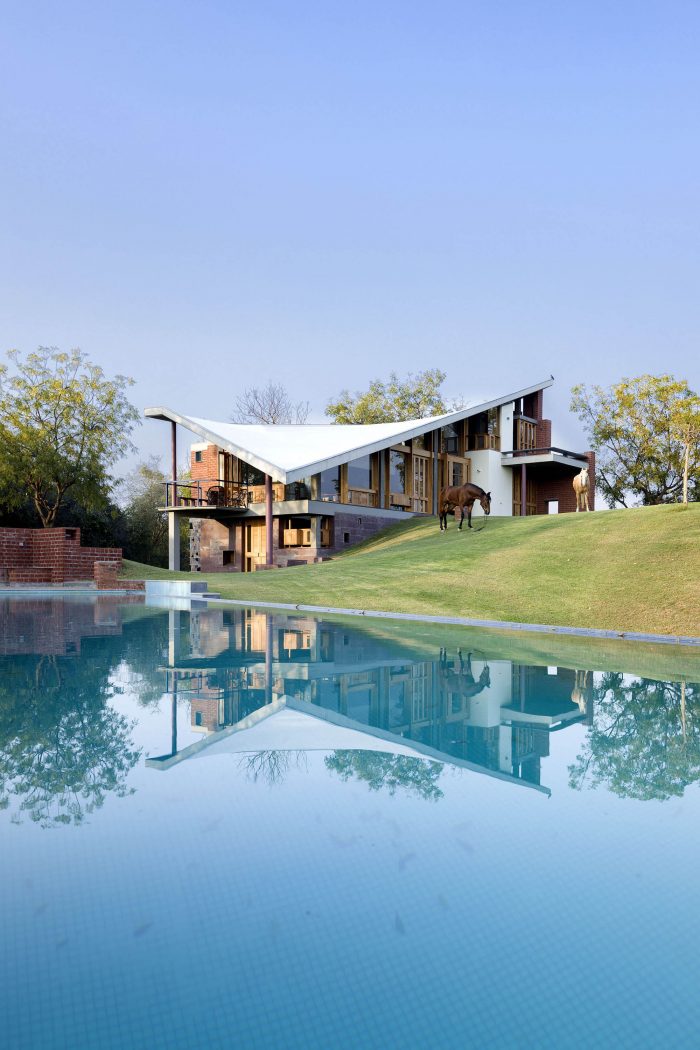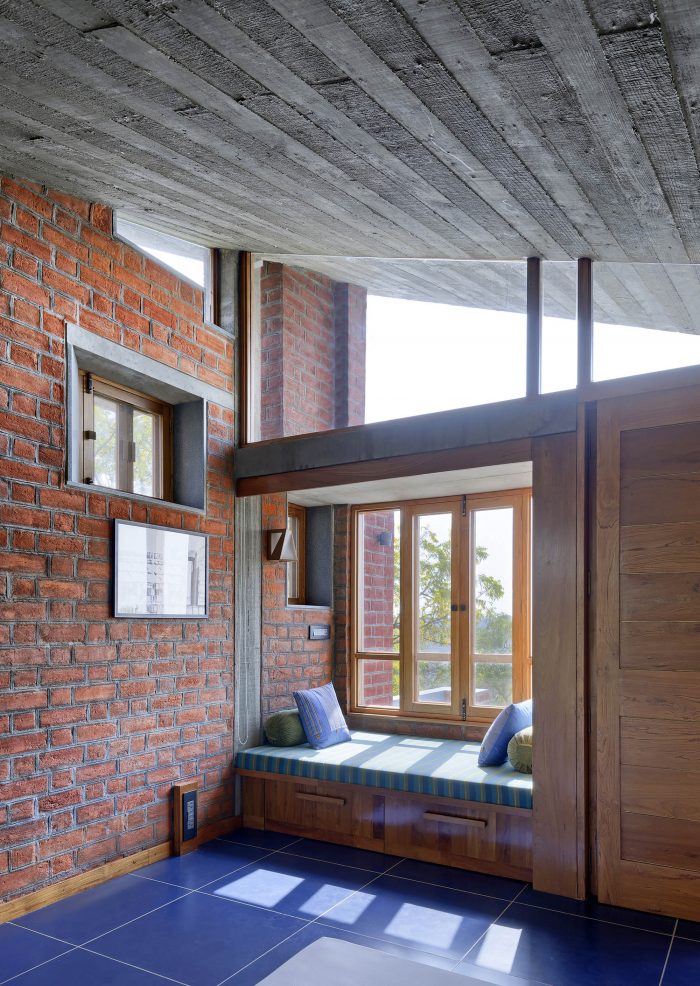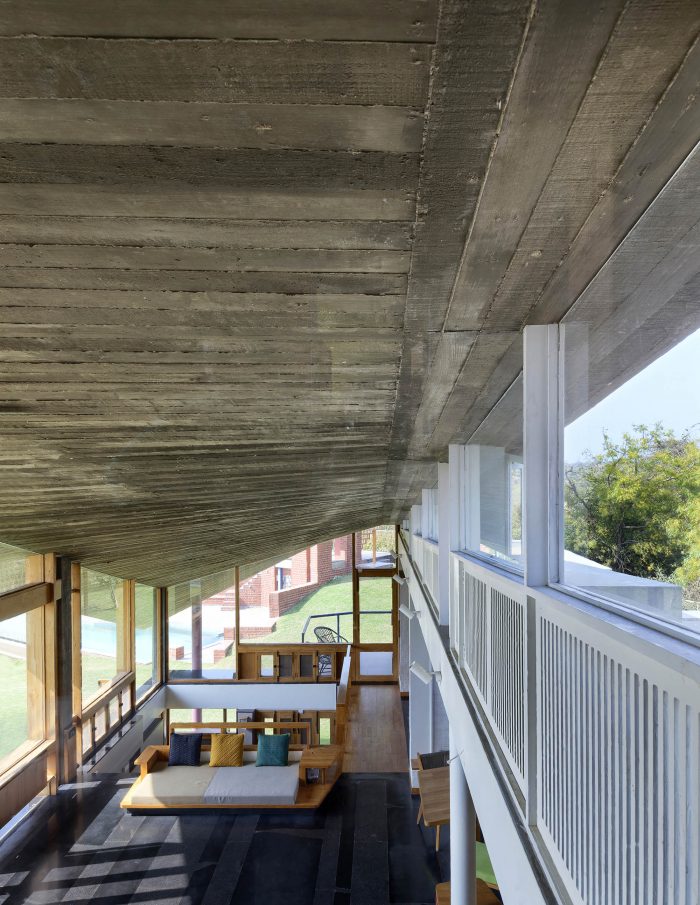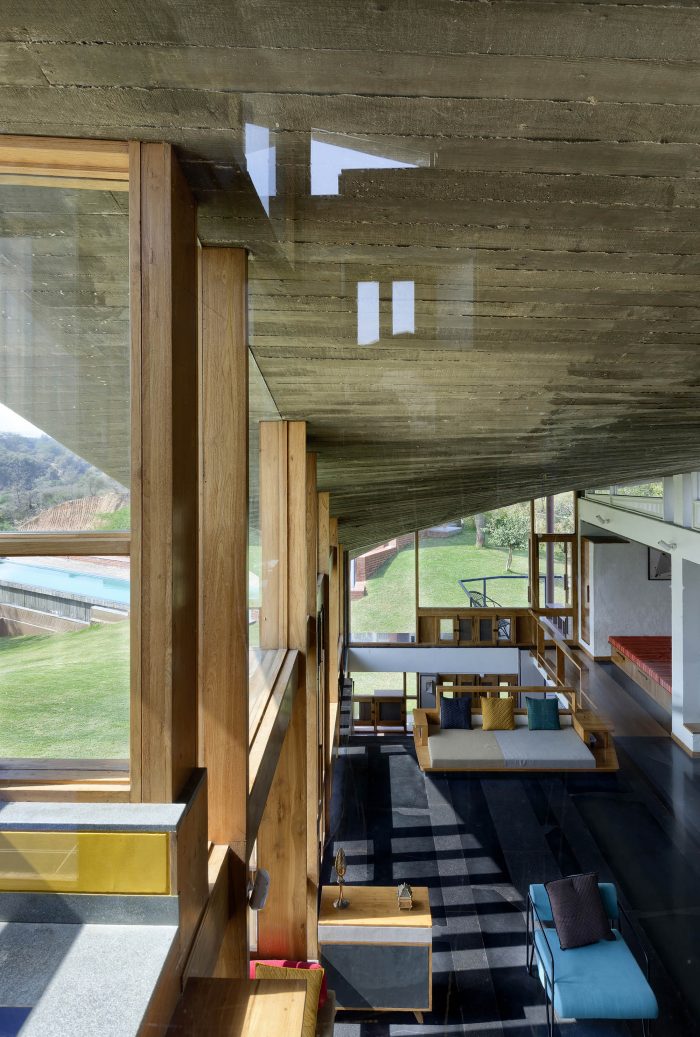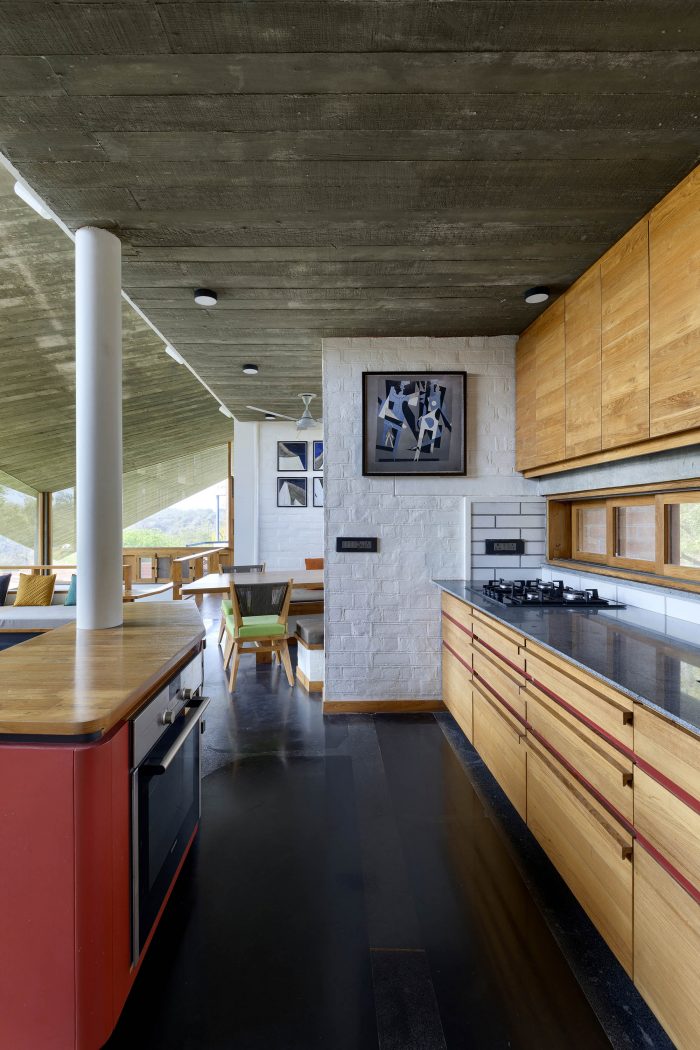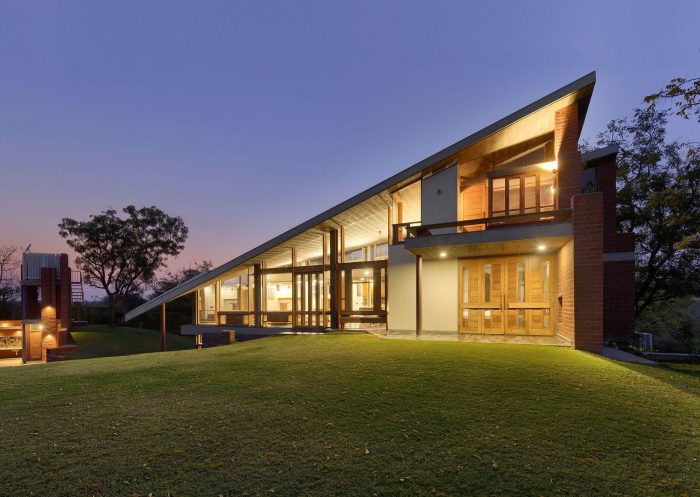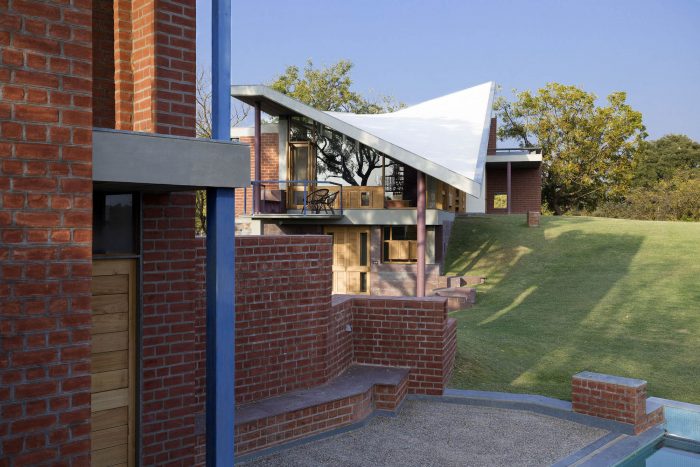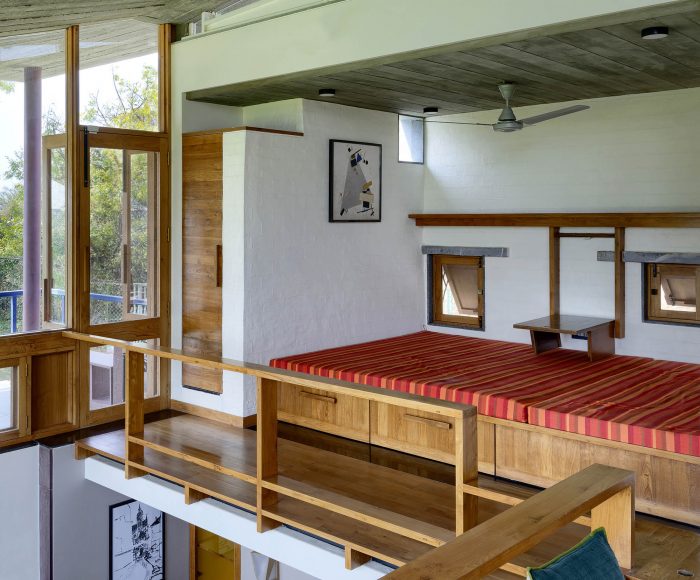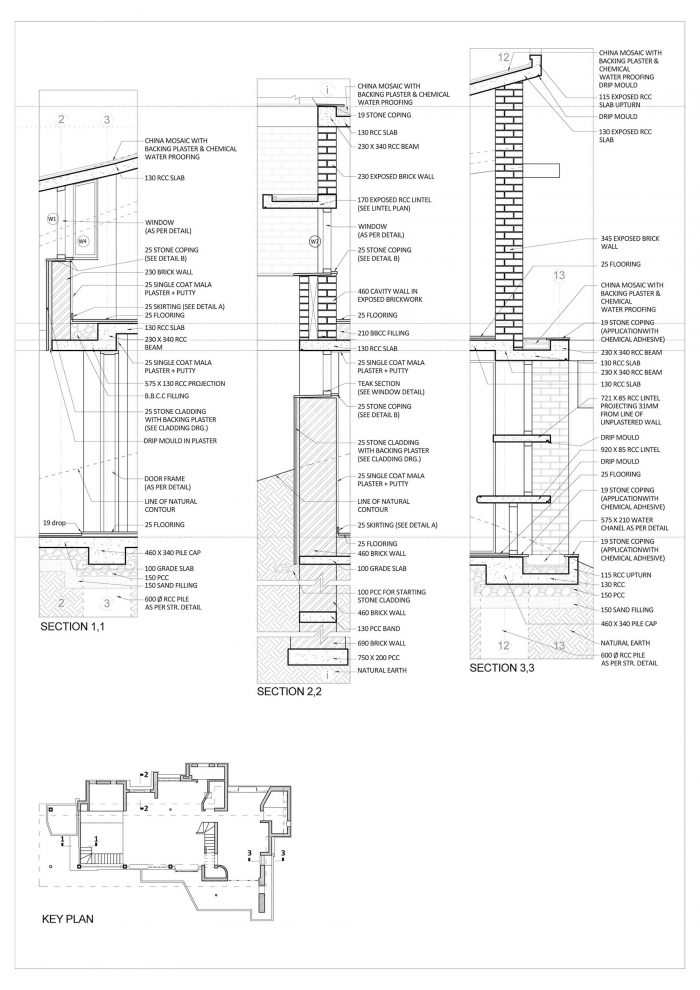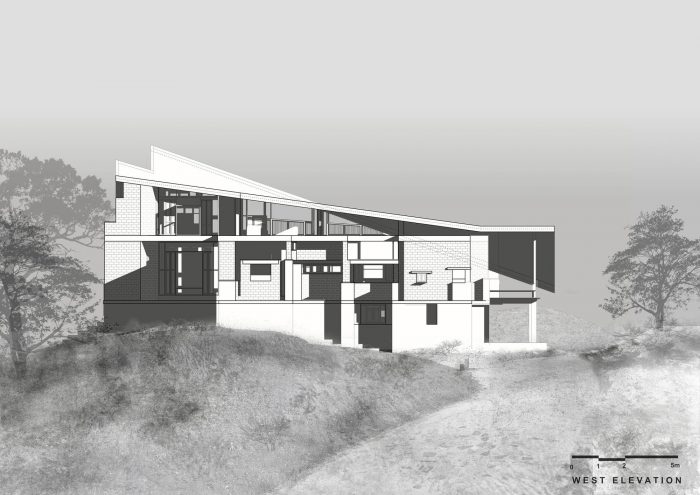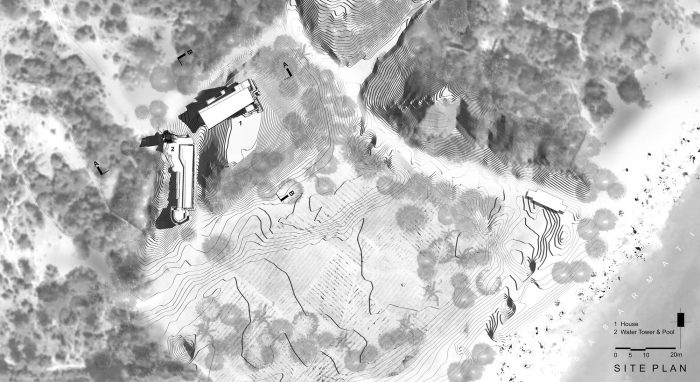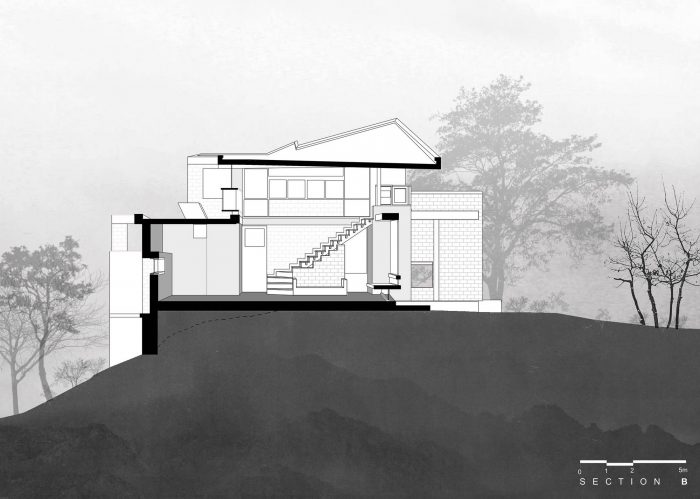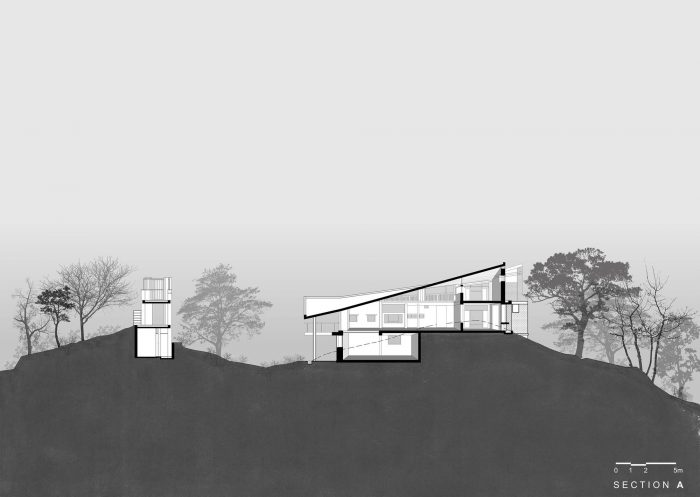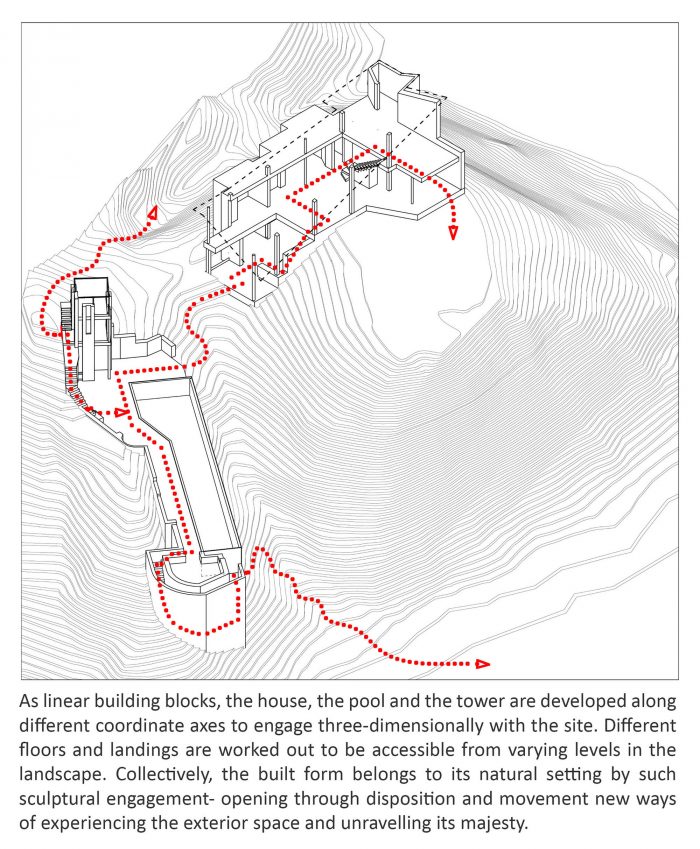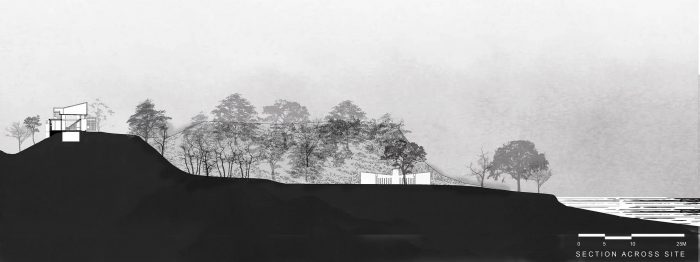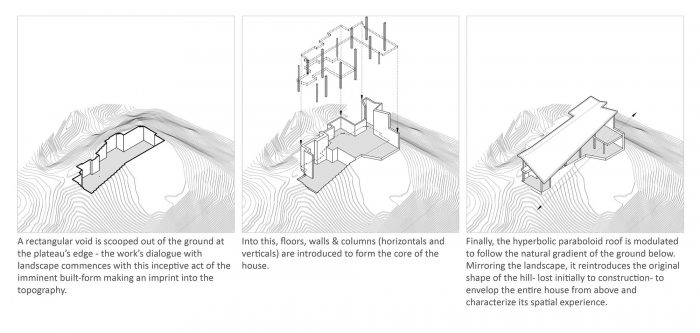背景–该项目提供了一个与位于艾哈迈达巴德附近Sabarmati河岸的原始森林场地接触的机会。由该地区的河流景观所塑造,起伏不定的场地从北面接近,包括一个高原–距离水位15米–走向其西边。从这里开始,当人们接近河流的边缘时,场地向东倾斜。所有的建筑决定都是为了保护场地的原始土地形态和生态环境,并限制干扰。
Context – Project was an opportunity to engage with a pristine, forested site, located on the banks of Sabarmati river near Ahmedabad. Shaped by the region’s riverine landscape, the undulating site is approached from the north and included a plateau- 15M from the water level- towards its western edge. From here, the site sloped down eastwards as one approached the river’s edge. All constructional decisions were made to preserve the original land form and ecology of the site with limited interference.
选址–主要建筑群–房屋、游泳池和水塔–位于最高的台地周围。房屋的长方形体量被推后并水平放置,其较长的一面面向河流,为户外活动留出了空间。在山谷的另一边,游泳池沿着其斜坡被雕刻在相邻的土堆上。再往南,砖石结构的水塔从对面山丘的最高点升起。
Siting – Principal built masses – the house, swimming pool and water tower – are located around the highest plateau. Leaving it free for outdoor activity, the house’s rectangular mass is pushed back and placed horizontally, with its longer side facing the river. Across the valley, the swimming pool is carved into the adjoining earth-mound along its slope. Further south, the masonry water tower rises from the highest point of the opposite hill.
作为线性建筑,房屋、游泳池和水塔沿着不同的坐标轴定向,与场地进行立体互动。在每个建筑中,都设计了不同的楼层和平台,以便从不同的景观层面进入。总的来说,通过这样的雕塑参与,建筑形式属于自然环境–通过处置和运动打开了体验外部空间的新方式,揭开了它的威严。
As linear blocks, the house, pool and water tower are oriented along different coordinate axes to engage three-dimensionally with the site. In each, different floors and landings are worked out to be accessible from varying levels of the landscape. Collectively, the built form belongs to the natural setting by such sculptural engagement- opening through disposition and movement new ways of experiencing the exterior space and unravelling its majesty.
组织与空间关系–厚重的挡土墙沿着高原的边缘曲折而行,将建筑稳定在斜坡上。它形成了紧凑的、类似房间的空间,容纳了厨房、餐厅、盥洗场、厕所、储藏室等服务设施。与此相反,一个大型的柱式大厅,从顶部被一个双曲面的抛物线覆盖,裸露的RCC屋顶,被发展到面向河流的边缘。这个连续的、类似于loggia的空间跨越不同的层次,支持生活、睡眠等。作品的关键组织动作包括通过山坡与河边景观、日落与月出、服务与服务空间等对立条件之间的辩证游戏来发展这些实体–房间和亭子。
Organization & Spatial relationships – A thick retaining wall courses zigzag along the plateau’s edge to stabilize the building on its slope. It forms compact, room-like spaces which accommodate services- kitchen, dining, wash-yard, toilets, storage, etc. In contrast, a large columned hall, covered from top by a hyperbolic paraboloid, exposed RCC roof, is developed towards the river facing edge. This continuous, loggia like space across different levels supports living, sleeping, etc. The work’s key organizational move involves developing these entities- the room and pavilion- through a dialectic play between opposing conditions of hillside v/s riverside view, sunset v/s moonrise, service v/s served space, etc.
通过在高原边缘挖出一个长方形的空隙来发展部分。通过这个即将建成的建筑形式在地形上留下印记的感知行为,开始了与地貌的对话。在这个过程中,地板、墙壁和柱子被引入,形成了房子的核心。最后,双曲面的抛物线型屋顶被调制成顺应下面地面的自然坡度。与景观相映成趣,它重新引入了山丘的原始形状–最初因建筑而失去的–从上而下地包围了整个房子,并描述了它的空间体验。
Section develops by scooping out a rectangular void at the plateau’s edge. The dialogue with landform commences through this inceptive act of the imminent built-form making an imprint into the topography. Into this, floors, walls & columns are introduced to form the core of the house. Finally, the hyperbolic paraboloid roof is modulated to follow the natural gradient of the ground below. Mirroring the landscape, it reintroduces the original shape of the hill- lost initially to construction- to envelop the entire house from above and characterize its spatial experience.
结构、施工与材料–项目采用复合结构体系。RCC屋顶是手工铸造的,使用松木百叶窗。柚木和玻璃板被用来制作门窗。在一些地方,它们被精心加厚,将家具融入其中,成为可居住的区域。在其他地方,它们被做得更薄,以包裹住结构,并最大限度地提高视野。外部石材包层一直延伸到地下室,消除了对可见基座保护的需求。它表达了建筑对景观的干预限制,使其被视为从地面上生长出来。
Structure, Construction & Materials – The project uses a composite structural system. The RCC roof is cast manually, using pinewood shuttering. Teakwood and glass panels are used to make door and windows. In places, they are carefully thickened to integrate furniture into them and become inhabitable zones. Elsewhere, they are made much thinner to wrap around the structure and maximize the view. Exterior stone cladding extends till the basement, eliminating the need for visible plinth protection. It expresses limits of building’s intervention into the landscape, allowing it to be perceived as literally growing out of the ground.
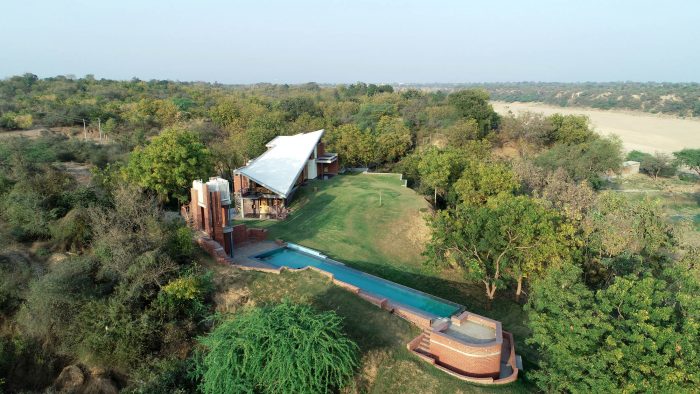
建筑师:Studio 4000
面积:3500平方米
年份:2021年
摄影:Rahul Zota
制造商:Duro, Kohler, Legrand, Saint-Gobain, Amulya WPC, Asian Paints, Balaji Granites, EPPW, Enox, Havells, NITCO TILES, Options, Philips, TATA
牵头建筑师:Khushboo Vyas, Smit Vyas
建筑图纸:Dipika Parikh, Dipti Kotak, Arjavi Mehta
建筑模型:Rahul Dhumale
承包商:Suresh Jadav
结构设计:Dilip Thummar
石头砌筑:Mukesh bhai
景观设计:Studio 4000
Mep咨询公司:Apurva Parikh
木工:Ganpat bhai Panchal
城市:Mubarakpur
国家:印度
Architects: Studio 4000
Area: 3500 m²
Year: 2021
Photographs: Rahul Zota
Manufacturers: Duro, Kohler, Legrand, Saint-Gobain, Amulya WPC, Asian Paints, Balaji Granites, EPPW, Enox, Havells, NITCO TILES, Options, Philips, TATA
Lead Architects:Khushboo Vyas, Smit Vyas
Architectural Drawings:Dipika Parikh, Dipti Kotak, Arjavi Mehta
Architectural Models:Rahul Dhumale
Contractor:Suresh Jadav
Structure Design:Dilip Thummar
Stone Masonry:Mukesh bhai
Landscape Design:Studio 4000
Mep Consultants:Apurva Parikh
Carpentry:Ganpat bhai Panchal
City:Mubarakpur
Country:India

